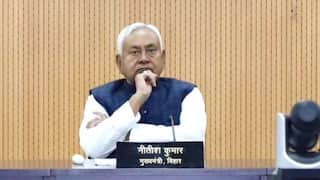GSLV-F12: ISRO Launches NVS-01, India’s First Second-Gen NaVIC Satellite. All About It
NVS-01 is a navigation satellite and will be a part of the Navigation with Indian Constellation (NaVIC) services. It weighs about 2,232 kilograms, and is equipped with an indigenous atomic clock.

GSLV-F12/NVS-01: The Indian Space Research Organisation (ISRO) launched India's first second-generation satellite on May 29, 2023. The satellite, called NVS-01, was launched atop ISRO's Geosynchronous Satellite Launch Vehicle (GSLV) at 10:42 am IST, from the Second Launch Pad, Satish Dhawan Space Centre, Sriharikota. The launch vehicle used for this mission is called GSLV-F12.
NVS-01 is a navigation satellite and will be a part of the Navigation with Indian Constellation (NaVIC) services. The satellite weighs about 2,232 kilograms, and is equipped with an indigenous atomic clock.
One can watch the launch of NVS-01 here:
GSLV-F12/NVS-01 Mission:
— ISRO (@isro) May 29, 2023
GSLV F12's 🚀
thunderous roar into the skies.....
Turn up the volume 🔊🔊
to enjoy this tracking 📽️ by our colleagues
at SDSC-SHAR, Sriharikota! pic.twitter.com/XZeE5LWgKW
NVS-01 was injected precisely into a Geosynchronous Transfer Orbit after a flight of about 19 minutes, ISRO said in a mission update.
The Indian space agency also said that the GSLV-F12/NVS-01 mission is accomplished.
ALSO READ | Science For Everyone: Why Colonising Mars Is Still Far From Reality
In order to reach the intended geosynchronous orbit, the satellite will perform orbit-raising manoeuvres.
NVS satellites will have enhanced NavIC features, and incorporate L1 band signals.
In October 2022, ISRO announced its plans to expand the NavIC system in order to increase its use in the civilian sector and by ships and aircraft travelling at large distances from India's borders.
Why NaVIC is important
NaVIC, earlier known as the Indian Regional Navigation Satellite System (IRNSS), is designed with a constellation of seven satellites, three of which are placed in geostationary orbit, and four are placed in an inclined geosynchronous orbit. The system also includes a network of ground stations operating 24x7.
NaVIC offers Standard Positioning Service (SPS), a real-time positioning and timing service, to civilian users, and ‘Restricted Service’ (encrypted services) for authorised users, including the military. The coverage area of NaVIC includes India and a region up to 1,500 kilometres beyond the country’s boundary.
Since several satellites belonging to the NaVIC constellation have outlived their lives, ISRO plans to replace at least five of them with the improved L-band. This would enable the satellites to offer better global positioning service (GPS) to the public.






































